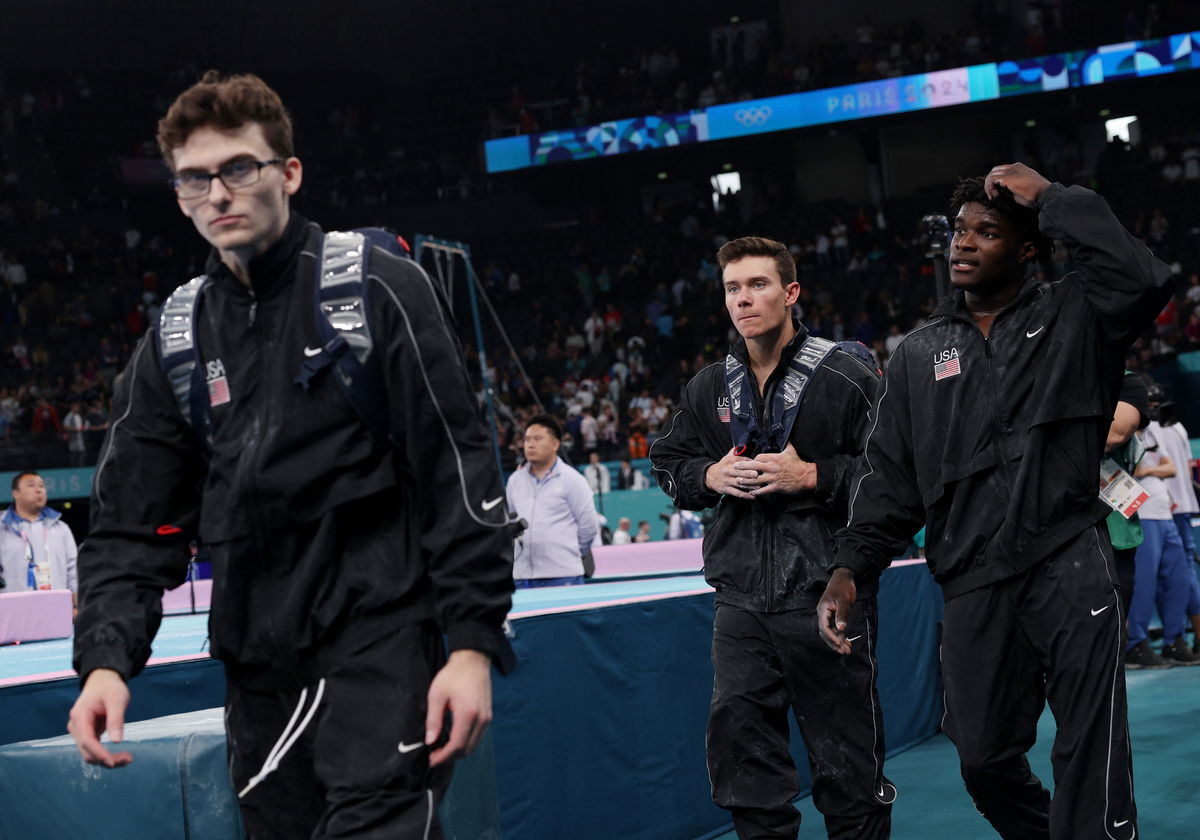
Reuters
Paris 2024 Olympics – Artistic Gymnastics – Men’s Qualification – Subdivision 1 – Bercy Arena, Paris, France – July 27, 2024. Frederick Richard, Brody Malone, and Stephen Nedoroscik of United States walk after performing. REUTERS/Amanda Perobelli

Reuters
Paris 2024 Olympics – Artistic Gymnastics – Men’s Qualification – Subdivision 1 – Bercy Arena, Paris, France – July 27, 2024. Frederick Richard, Brody Malone, and Stephen Nedoroscik of United States walk after performing. REUTERS/Amanda Perobelli
Here comes the axe! Will Ohio State University be the 38th on the list to cut ties with men’s gymnastics?
Watch What’s Trending Now!
No. For now, sources suggest that they’re only wiping out the athletic scholarships, and not the program. As disappointing as it is, was it not a long time coming?
Data from the NCAA suggests that participation in men’s gymnastics has faced a drastic drop over the years. From 59 Division-I men’s programs in 1981, it has dropped by 79.6%, with 12 programs in 2024. This change, according to sources, was eminent. Under a model of revenue sharing, the NCAA would allow universities to set aside up to $21` million in revenue for athletes per year. However, this will soon undergo a few changes, pushing universities to make difficult decisions regarding other programs too.
ADVERTISEMENT
Although there has been no update on how soon this will be implemented, NBC4’s sports anchor Whitney Harding reported,
“We knew this was a possibility. My sources have been telling me for a while that they feared this because changes are coming to how money in college sports is spent.
“The NCAA rules are changing to allow universities to pay some athletes to have the money to do that. Universities say they must be forced to make tough financial decisions impacting some of their programs. Now, we have reached out to Ohio State… This is something, that we have heard, could possibly happen.
ADVERTISEMENT
When asked how many athletes would be impacted if such a move were to happen, Harding said, “The number of scholarships that the men’s gymnastics teams have is kind of scattered amongst the entire team. So, it’s not saying if they have like, say, six scholarships, six athletes are affected […] It could affect the entire team. We don’t know how it’s divided up because that is how it has been working since the decline that we’ve mentioned around the country.”
But, with OSU, here’s how they have reached such a fate.
ADVERTISEMENT
Unlike what happened with Temple University where collegiate funds for the men’s program were reallocated to recruit coaching staff for the women’s branch four years ago, Ohio State at that point of time still had the faintest of hopes alive. And how? They had excellent backing from the administration that went above and beyond to get the resources for the athletes from across the country. Just hear what the then Gymnastics Director of Athletics Drew Moling had to say then,
“Our athletic department is still supporting us as much as they can and we are very appreciative of that.”
But four years on, it looks like they ultimately couldn’t sustain, and that the program is under threat. Although 2x Olympic bronze medalist Stephen Nedoroscik, whose pommel horse routine led the USA men’s team to end their 16-year drought, too reacted on X on Friday,
ADVERTISEMENT
“Ohio State removing athletic scholarships from Men’s Gymnastics. Yet again, another step backwards for MGYM. With the success of current and former NCAA gymnasts at the Olympics you’d think NCAA programs would be excited for the upcoming season, not stripping away opportunities.”
Sure, the 25-year-old Nedoroscik’s score of 15.3 won him bronze but he inevitably just spiraled up to become a phenom overnight! The Paris Olympics seemed like the ideal place to start, and it worked! Just weeks after his bronze wins, he admitted, “I’ve just been consistently on top of the world for the past week now. I literally had to go and turn off my notifications yesterday because I needed to be able to lock in for this competition.”
Although the 25-year-old pommel horse specialist had wished differently, the issues run deeper than we think. As predicted by many, more institutions are in line to be impacted in the coming times. However, there has been no immediate response from Ohio State so far.
ADVERTISEMENT
ADVERTISEMENT
ADVERTISEMENT
ADVERTISEMENT

